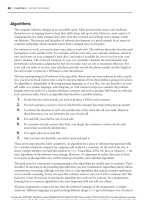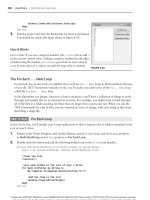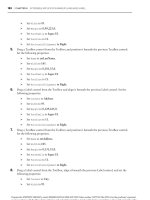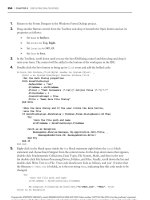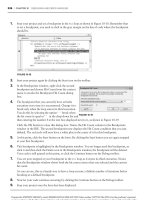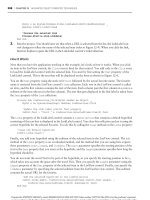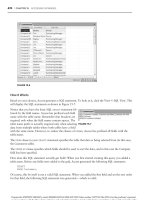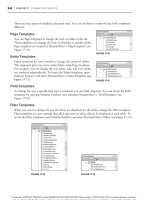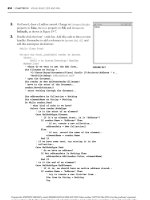Beginning Microsoft Visual Basic 2008 phần 3 doc
Bạn đang xem bản rút gọn của tài liệu. Xem và tải ngay bản đầy đủ của tài liệu tại đây (1.2 MB, 92 trang )
Chapter 5: Working with Data Structures
151
3. Here’s the problem: The user doesn’t know what 2 means. Close the project and find the
following section of code at the end of the
Hour property:
‘Set the display text
lblState.Text = “At “ & value & “:00, Richard is “ & _
CurrentState
End Set
4. Change the last line to read as follows:
‘Set the display text
lblState.Text = “At “ & value & “:00, Richard is “ & _
CurrentState.ToString
End Set
5. Now run the project and you’ll see something like Figure 5-9.
Figure 5-9
How It Works
As you typed the code, you might have noticed that whenever you tried to set a value against
CurrentState, you were presented with an enumerated list of possibilities as shown in Figure 5-10.
Figure 5-10
Visual Studio 2008 knows that
CurrentState is of type DayAction. It also knows that DayAction is an
enumeration and that it defines eight possible values, each of which is displayed in the IntelliSense pop-up
box. Clicking an item in the enumerated list causes a tooltip to be displayed with the actual value of the
item; for example, clicking
DayAction.RelaxingWithFriends will display a tooltip with a value of 6.
c05.indd 151c05.indd 151 4/2/08 5:31:50 PM4/2/08 5:31:50 PM
Chapter 5: Working with Data Structures
152
Fundamentally, however, because DayAction is based on an integer, CurrentState is an integer
value. That’s why, the first time you ran the project with the state determination code in place, you
saw an integer at the end of the status string. At 7
A.M., you know that Richard is traveling to work, or
rather
CurrentState equals DayAction.TravelingToWork. You defined this as 2, which is why 2 is
displayed at the end of the string.
What you’ve done in this Try It Out is to tack a call to the
ToString method onto the end of the
CurrentState variable. This results in a string representation of DayAction being used, rather than
the integer representation
Enumerations are incredibly useful when you want to store one of a possible set of values in a variable.
As you start to drill into more complex objects in the Framework, you’ll find that they are used all over
the place!
Setting Invalid Values
One of the limitations of enumerations is that it is possible to store a value that technically isn’t one of
the possible defined values of the enumeration. For example, you can change the
Hour property so that
rather than setting
CurrentState to Asleep, you can set it to 999:
ElseIf value >= 22 And value < 23 Then
CurrentState = DayAction.GettingReadyForBed
Else
CurrentState = 999
End If
If you build the project, you’ll notice that Visual Basic 2008 doesn’t flag this as an error if you have the
Option Strict option turned off. When you run the project, you’ll see that the value for
CurrentState is
shown on the form as 999.
So, you can see that you can set a variable that references an enumeration to a value that is not defined in
that enumeration and the application will still “work” (as long as the value is of the same type as the
enumeration). If you build classes that use enumerations, you have to rely on the consumer of that class
being well behaved. One technique to solve this problem would be to disallow invalid values in any
properties that used the enumeration as their data type.
c05.indd 152c05.indd 152 4/2/08 5:31:50 PM4/2/08 5:31:50 PM
Chapter 5: Working with Data Structures
153
Understanding Constants
Another good programming practice that you need to look at is the constant. Imagine you have these two
methods, each of which does something with a given file on the computer’s disk. (Obviously, we’re
omitting the code here that actually manipulates the file.)
Public Sub DoSomething()
‘What’s the filename?
Dim strFileName As String = “c:\Temp\Demo.txt”
‘Open the file
End Sub
Public Sub DoSomethingElse()
‘What’s the filename?
Dim strFileName As String = “c:\Temp\Demo.txt”
‘Do something with the file
End Sub
Using Constants
The code defining a string literal gives the name of a file twice. This is poor programming practice
because if both methods are supposed to access the same file, and if that file name changes, this change
has to be made in two separate places.
In this instance, both methods are next to each other and the program itself is small. However, imagine
you had a massive program in which a separate string literal pointing to the file is defined in 10, 50, or
even 1,000 places. If you needed to change the file name, you’d have to change it many times. This is
exactly the kind of thing that leads to serious problems for maintaining software code.
What you need to do instead is define the file name globally and then use that global symbol for the file name
in the code, rather than using a string literal. This is what a constant is. It is, in effect, a special kind of variable
that cannot be varied when the program is running. In the next Try It Out, you learn to use constants.
1. Create a new Windows Forms Application in Visual Studio 2008 called Constants Demo.
2. When the Forms Designer appears, add three Button controls. Set the Name property of the first button
to btnOne, the second to btnTwo, and the third to btnThree. Change the
Text property of each to
One, Two, and Three, respectively. Arrange the controls on your form so it looks similiar Figure 5-11.
Try It Out
Using Constants
Figure 5-11
c05.indd 153c05.indd 153 4/2/08 5:31:50 PM4/2/08 5:31:50 PM
Chapter 5: Working with Data Structures
154
3. View the Code Editor for the form by right-clicking the form and choosing View Code from
the context menu. At the top of the class definition, add the following highlighted code:
Public Class Form1
‘File name constant
Private Const strFileName As String = “C:\Temp\Hello.txt”
4. In the Class Name combo box at the top of the editor, select btnOne, and in the Method Name
combo box select the
Click event. Add the following highlighted code to the Click event
handler:
Private Sub btnOne_Click(ByVal sender As Object, _
ByVal e As System.EventArgs) Handles btnOne.Click
‘Using a constant
MessageBox.Show(“1: “ & strFileName, “Constants Demo”)
End Sub
5. Select btnTwo in the Class Name combo box and select its Click event in the Method Name
combo box. Add the highlighted code:
Private Sub btnTwo_Click(ByVal sender As Object, _
ByVal e As System.EventArgs) Handles btnTwo.Click
‘Using the constant again
MessageBox.Show(“2: “ & strFileName, “Constants Demo”)
End Sub
6. Select btnThree in the Class Name combo box and the Click event in the Method Name
combo box. Add this code to the
Click event handler:
Private Sub btnThree_Click(ByVal sender As Object, _
ByVal e As System.EventArgs) Handles btnThree.Click
‘Reusing the constant one more time
MessageBox.Show(“3: “ & strFileName, “Constants Demo”)
End Sub
7. Save and run your project and then click button One. You’ll see the message box shown in
Figure 5-12.
Figure 5-12
c05.indd 154c05.indd 154 4/2/08 5:31:51 PM4/2/08 5:31:51 PM
Chapter 5: Working with Data Structures
155
Likewise, you’ll see the same file name when you click buttons Two and Three.
How It Works
A constant is actually a type of value that cannot be changed when the program is running. It is
defined as a variable, but you add
Const to the definition indicating that this variable is constant and
cannot change.
‘File name constant
Private Const strFileName As String = “C:\Temp\Hello.txt”
You’ll notice that it has a data type, just like a variable, and you have to give it a value when it’s
defined — which makes sense, because you can’t change it later.
When you want to use the constant, you refer to it just as you would refer to any variable:
Private Sub btnOne_Click(ByVal sender As Object, _
ByVal e As System.EventArgs) Handles btnOne.Click
‘Using a constant
MessageBox.Show(“1: “ & strFileName, “Constants Demo”)
End Sub
As mentioned before, the appeal of a constant is that it allows you to change a value that’s used
throughout a piece of code by altering a single piece of code. However, note that you can change
constants only at design time; you cannot change their values at runtime. Look at how this works.
Different Constant Types
In this section, you’ve seen how to use a string constant, but you can use other types of variables as
constants. There are some rules: Basically, a constant must not be able to change, so you should not store
an object data type (which we will discuss in Chapter 11) in a constant.
Integers are very common types of constants. They can be defined like this:
Public Const intHoursAsleepPerDay As Integer = 8
Also, it’s fairly common to see constants used with enumerations, like this:
Public Const intRichardsTypicalState As DayAction = DayAction.AtWork
Structures
Applications commonly need to store several pieces of information of different data types that all relate
to one thing and must be kept together in a group, such as a customer’s name and address (strings) and
balance (a number). Usually, an object of a class is used to hold such a group of variables, as you’ll
c05.indd 155c05.indd 155 4/2/08 5:31:51 PM4/2/08 5:31:51 PM
Chapter 5: Working with Data Structures
156
discover in Chapter 11, but you can also use a structure. Structures are similar to class objects but are
somewhat simpler, so they’re discussed here.
Later on, as you design applications, you need to be able to decide whether to use a structure or a class.
As a rule of thumb, we suggest that if you end up putting a lot of methods on a structure, it should
probably be a class. It’s also relatively tricky to convert from a structure to a class later on, because
structures and objects are created using different syntax rules, and sometimes the same syntax produces
different results between structures and objects. So choose once and choose wisely!
Building Structures
Take a look at how you can build a structure.
Try It Out
Building a Structure
1.
Create a new Windows Forms Application in Visual Studio 2008 called Structure Demo.
2. When the Forms Designer appears add four Label controls, four TextBox controls, and a
Button control. Arrange your controls so that they look similar to Figure 5-13.
3. Set the Name properties as follows:
❑ Set Label1 to lblName.
❑ Set TextBox1 to txtName.
❑ Set Label2 to lblFirstName.
❑ Set TextBox2 to txtFirstName.
❑ Set Label3 to lblLastName.
❑ Set TextBox3 to txtLastName.
❑ Set Label4 to lblEmail.
❑ Set TextBox4 to txtEmail.
❑ Set Button1 to btnListCustomer.
4. Set the Text properties of the following controls:
❑ Set lblName to Name.
❑ Set lblFirstName to First Name.
❑ Set lblLastName to Last Name.
❑ Set lblEmail to E-mail.
❑ Set btnListCustomer to List Customer.
c05.indd 156c05.indd 156 4/2/08 5:31:52 PM4/2/08 5:31:52 PM
Chapter 5: Working with Data Structures
157
5. Right-click the project name in the Solution Explorer, choose the Add menu item from the con-
text menu, and then choose the Class submenu item. In the Add New Item – Structure Demo
dialog box, enter Customer in the Name field and then click the Add button to have this item
added to your project.
6. When the Code Editor appears, replace all existing code with the following code:
Public Structure Customer
‘Public members
Public FirstName As String
Public LastName As String
Public Email As String
End Structure
Note that you must make sure to replace the Class definition with the Structure definition!
7. View the Code Editor for the form and add this procedure:
Public Class Form1
Public Sub DisplayCustomer(ByVal customer As Customer)
‘Display the customer details on the form
txtFirstName.Text = customer.FirstName
txtLastName.Text = customer.LastName
txtEmail.Text = customer.Email
End Sub
8. In the Class Name combo box at the top of the editor, select btnListCustomer, and in the
Method Name combo box select the
Click event. Add the following highlighted code to the
Click event handler:
Private Sub btnListCustomer_Click(ByVal sender As System.Object, _
ByVal e As System.EventArgs) Handles btnListCustomer.Click
‘Create a new customer
Dim objCustomer As Customer
objCustomer.FirstName = “Michael”
objCustomer.LastName = “Dell”
objCustomer.Email = “”
‘Display the customer
DisplayCustomer(objCustomer)
End Sub
Figure 5-13
c05.indd 157c05.indd 157 4/2/08 5:31:52 PM4/2/08 5:31:52 PM
Chapter 5: Working with Data Structures
158
9.
Save and run your project. When the form appears, click the List Customer button and you
should see results similar to those shown in Figure 5-14.
Figure 5-14
How It Works
You define a structure using a Structure End Structure statement. Inside this block, the vari-
ables that make up the structure are declared by name and type: These variables are called members of
the structure.
Public Structure Customer
‘Public members
Public FirstName As String
Public LastName As String
Public Email As String
End Structure
Notice the keyword Public in front of each variable declaration as well as in front of the Structure
statement. You have frequently seen
Private used in similar positions. The Public keyword means
that you can refer to the member (such as
FirstName) outside of the definition of the Customer
structure itself.
In the
btnListCustomer_Click procedure, you define a variable of type Customer using the Dim
statement. (If
Customer were a class, you would also have to initialize the variable by setting
objCustomer equal to New Customer, as will be discussed in Chapter 11.)
Private Sub btnListCustomer_Click(ByVal sender As System.Object, _
ByVal e As System.EventArgs) Handles btnListCustomer_Click.Click
‘Create a new customer
Dim objCustomer As Customer
Then you can access each of the member variables inside the Customer structure objCustomer by
giving the name of the structure variable, followed by a dot, followed by the name of the member:
objCustomer.FirstName = “Michael”
objCustomer.LastName = “Dell”
objCustomer.Email = “”
‘Display the customer
DisplayCustomer(objCustomer)
End Sub
c05.indd 158c05.indd 158 4/2/08 5:31:53 PM4/2/08 5:31:53 PM
Chapter 5: Working with Data Structures
159
The DisplayCustomer procedure simply accepts a Customer structure as its input parameter and
then accesses the members of the structure to set the
Text properties of the text boxes on the form:
Public Sub DisplayCustomer(ByVal customer As Customer)
‘Display the customer details on the form
txtFirstName.Text = customer.FirstName
txtLastName.Text = customer.LastName
txtEmail.Text = customer.Email
End Sub
Adding Properties to Structures
You can add properties to a structure, just as you did to the form in the Enum Demo project earlier in the
chapter. You learn how in the next Try It Out.
1. Open the Code Editor for Customer and add this highlighted code to create a read-only
property
Name:
‘Public members
Public FirstName As String
Public LastName As String
Public Email As String
‘Name property
Public ReadOnly Property Name() As String
Get
Return FirstName & “ “ & LastName
End Get
End Property
2. Open the Code Editor for Form1. Modify the DisplayCustomer method with the highlighted
code:
Public Sub DisplayCustomer(ByVal customer As Customer)
‘Display the customer details on the form
txtName.Text = customer.Name
txtFirstName.Text = customer.FirstName
txtLastName.Text = customer.LastName
txtEmail.Text = customer.Email
End Sub
3. Run the project and click the List Customer button. You’ll see that the Name text box, which
was empty in Figure 5-14, is now populated with the customer’s first and last name.
Try It Out
Adding a Name Property
c05.indd 159c05.indd 159 4/2/08 5:31:55 PM4/2/08 5:31:55 PM
Chapter 5: Working with Data Structures
160
Working with ArrayLists
Suppose you need to store a set of Customer structures. You could use an array, but in some cases the
array might not be so easy to use.
❑ If you need to add a new Customer to the array, you need to change the size of the array and
insert the new item in the new last position in the array. (You’ll learn how to change the size of
an array later in this chapter.)
❑ If you need to remove a Customer from the array, you need to look at each item in the array in
turn. When you find the one you want, you have to create another version of the array one
element smaller than the original array and copy every item except the one you want to delete
into the new array.
❑ If you need to replace a Customer in the array with another customer, you need to look at each
item in turn until you find the one you want and then replace it manually.
The
ArrayList provides a way to create an array that can be easily manipulated as you run your
program.
Using an ArrayList
Look at using an ArrayList in this next Try It Out.
1. Return to the Structure Demo project in Visual Studio 2008. Make the form larger, move the
existing controls down, and then add a new ListBox control as shown in Figure 5-15.
Set the
Name property of the list box to lstCustomers and its IntegralHeight property to False.
You can click the form and press Ctrl+A to select all of the controls and then drag them to their
new location.
Try It Out
Using an ArrayList
Figure 5-15
c05.indd 160c05.indd 160 4/2/08 5:31:55 PM4/2/08 5:31:55 PM
Chapter 5: Working with Data Structures
161
2. Open the Code Editor for Form1 and add the member highlighted here to the top of the class
definition:
Public Class Form1
‘Form level members
Private objCustomers As New ArrayList
3. Add this method to Form1 to create a new customer:
Public Sub CreateCustomer(ByVal firstName As String, _
ByVal lastName As String, ByVal email As String)
‘Declare a Customer object
Dim objNewCustomer As Customer
‘Create the new customer
objNewCustomer.FirstName = firstName
objNewCustomer.LastName = lastName
objNewCustomer.Email = email
‘Add the new customer to the list
objCustomers.Add(objNewCustomer)
‘Add the new customer to the ListBox control
lstCustomers.Items.Add(objNewCustomer)
End Sub
4. Modify the btnListCustomer_Click method next, making these code changes:
Private Sub btnListCustomer_Click(ByVal sender As System.Object, _
ByVal e As System.EventArgs) Handles btnListCustomer.Click
‘Create some customers
CreateCustomer(“Darrel”, “Hilton”, “”)
CreateCustomer(“Frank”, “Peoples”, “”)
CreateCustomer(“Bill”, “Scott”, “”)
End Sub
5. Run the project and click the List Customer button. You’ll see results like those shown in
Figure 5-16.
Figure 5-16
c05.indd 161c05.indd 161 4/2/08 5:31:57 PM4/2/08 5:31:57 PM
Chapter 5: Working with Data Structures
162
You are adding Customer structures to the list, but they are being displayed by the list as Structure_
Demo.Customer
; this is the full name of the structure. The ListBox control accepts string values, so, by
specifying that you wanted to add the
Customer structure to the list box, Visual Basic 2008 called the
ToString method of the Customer structure. By default, the ToString method for a structure returns
the structure name, not the contents that you wanted to see. So what you want to do is tweak the
Customer structure so that it can display something more meaningful. When you do that in the next Try
It Out, you’ll see how the
ArrayList works.
1. Return to the Structure Demo project and open the Code Editor for Customer and add the
following method to the structure, ensuring that it is below the member declarations.
Remember from Chapter 3 that to insert an XML Document Comment block, you type three
apostrophes above the method name:
‘’’ <summary>
‘’’ Overrides the default ToString method
‘’’ </summary>
‘’’ <returns>String</returns>
‘’’ <remarks>Returns the customer name and email address</remarks>
Public Overrides Function ToString() As String
Return Name & “ (“ & Email & “)”
End Function
End Structure
2. Run the project and click the List Customer button. You’ll see the same results as shown in
Figure 5-17.
Try It Out
Overriding ToString
Figure 5-17
c05.indd 162c05.indd 162 4/2/08 5:31:57 PM4/2/08 5:31:57 PM
Chapter 5: Working with Data Structures
163
How It Works
Whenever a Customer structure is added to the list, the list box calls the ToString method on the
structure to get a string representation of that structure. With this code, you override the default func-
tionality of the
ToString method so that, rather than returning just the name of the structure, you get
some useful text:
‘’’ <summary>
‘’’ Overrides the default ToString method
‘’’ </summary>
‘’’ <returns>String</returns>
‘’’ <remarks>Returns the customer name and email address</remarks>
Public Overrides Function ToString() As String
Return Name & “ (“ & Email & “)”
End Function
An ArrayList can be used to store a list of objects/structures of any type (in contrast to a regular
array). In fact, you can mix the types within an
ArrayList — a topic we’ll be talking about in a little
while. In this example, you created a method called
CreateCustomer that initializes a new Customer
structure based on parameters that were passed to the method:
Public Sub CreateCustomer(ByVal firstName As String, _
ByVal lastName As String, ByVal email As String)
‘Declare a Customer object
Dim objNewCustomer As Customer
‘Create the new customer
objNewCustomer.FirstName = firstName
objNewCustomer.LastName = lastName
objNewCustomer.Email = email
After the structure has been initialized, you add it to the ArrayList stored in objCustomers:
‘Add the new customer to the list
objCustomers.Add(objNewCustomer)
You also add it to the list box itself, like this:
‘Add the new customer to the ListBox control
lstCustomers.Items.Add(objNewCustomer)
With CreateCustomer defined, you can call it to add new members to the ArrayList and to the List-
Box control when the user clicks the List Customer button:
Private Sub btnListCustomer_Click(ByVal sender As System.Object, _
ByVal e As System.EventArgs) Handles btnListCustomer.Click
‘Create some customers
CreateCustomer(“Darrel”, “Hilton”, “”)
CreateCustomer(“Frank”, “Peoples”, “”)
CreateCustomer(“Bill”, “Scott”, “”)
End Sub
c05.indd 163c05.indd 163 4/2/08 5:31:58 PM4/2/08 5:31:58 PM
Chapter 5: Working with Data Structures
164
Deleting from an ArrayList
OK, so now you know the principle behind an ArrayList. You use it to do something that’s
traditionally hard to do with arrays but is pretty easy to do with an
ArrayList, such as dynamically
adding new values. Now let’s look at how easy it is to delete items from an
ArrayList.
1. Return to the Code Editor in the Structure Demo project and add the SelectedCustomer
property to the form as follows:
Public ReadOnly Property SelectedCustomer() As Customer
Get
If lstCustomers.SelectedIndex <> -1 Then
‘Return the selected customer
Return CType(objCustomers(lstCustomers.SelectedIndex), Customer)
End If
End Get
End Property
2. Now switch to the Forms Designer and add a new Button control to the bottom of the form
and set its
Name property to btnDeleteCustomer and its Text property to Delete Customer.
3. Double-click the button and add the highlighted code:
Private Sub btnDeleteCustomer_Click(ByVal sender As System.Object, _
ByVal e As System.EventArgs) Handles btnDeleteCustomer.Click
‘If no customer is selected in the ListBox then
If lstCustomers.SelectedIndex = -1 Then
‘Display a message
MessageBox.Show(“You must select a customer to delete.”, _
“Structure Demo”)
‘Exit this method
Exit Sub
End If
‘Prompt the user to delete the selected customer
If MessageBox.Show(“Are you sure you want to delete “ & _
SelectedCustomer.Name & “?”, “Structure Demo”, _
MessageBoxButtons.YesNo, MessageBoxIcon.Question) = _
DialogResult.Yes Then
‘Get the customer to be deleted
Dim objCustomerToDelete As Customer = SelectedCustomer
‘Remove the customer from the ArrayList
Try It Out
Deleting Customers
c05.indd 164c05.indd 164 4/2/08 5:31:58 PM4/2/08 5:31:58 PM
Chapter 5: Working with Data Structures
165
objCustomers.Remove(objCustomerToDelete)
‘Remove the customer from the ListBox
lstCustomers.Items.Remove(objCustomerToDelete)
End If
End Sub
4. Run the project and click the List Customer button. Do not select a customer in the list box and
then click the Delete Customer button. You’ll see a message box indicating that you must
select a customer.
5. Now select a customer and click Delete Customer. You’ll see a confirmation dialog box similar
to the one shown in Figure 5-18.
6. Click Yes, and the customer you selected will be removed from the list.
Figure 5-18
How It Works
The trick here is to build a read-only property that returns the Customer structure that’s selected
in the list box back to the caller on demand. The
SelectedIndex property of the list box returns a
value of
-1 if no selection has been made. Otherwise it returns the zero-based index of the selected
customer. Since the
Items collection of the list box contains a collection of Object data types, you
must convert the object returned to a
Customer object, which you do by using the CType function.
Public ReadOnly Property SelectedCustomer() As Customer
Get
If lstCustomers.SelectedIndex <> -1 Then
‘Return the selected customer
Return CType(objCustomers(lstCustomers.SelectedIndex), Customer)
End If
End Get
End Property
c05.indd 165c05.indd 165 4/2/08 5:31:59 PM4/2/08 5:31:59 PM
Chapter 5: Working with Data Structures
166
Like the Name property that you added to the Customer structure, this property is identified as read-
only by the keyword
ReadOnly. It contains a Get block but no Set block. The reason for making it
read-only is that it constructs the value it returns from other information (the contents of the
Cus-
tomer
structures in the list) that can be set and changed by other means.
Inside the
Click event handler for the Delete Customer button, you first test to see whether a cus-
tomer has been selected in the list box. If no customer has been selected, you display a message box
indicating that a customer must be selected. Then you exit the method allowing the user to select a
customer and try again:
‘If no customer is selected in the ListBox then
If lstCustomers.SelectedIndex = -1 Then
‘Display a message
MessageBox.Show(“You must select a customer to delete.”, _
“Structure Demo”)
‘Exit this method
Exit Sub
End If
If a customer has been selected, you prompt the user to confirm the deletion:
‘Prompt the user to delete the selected customer
If MessageBox.Show(“Are you sure you want to delete “ & _
SelectedCustomer.Name & “?”, “Structure Demo”, _
MessageBoxButtons.YesNo, MessageBoxIcon.Question) = _
DialogResult.Yes Then
If the user does want to delete the customer, you get a return value from MessageBox.Show equal to
DialogResult.Yes. Then you declare a customer structure to save the customer to be deleted and
populate that structure with the selected customer:
‘Get the customer to be deleted
Dim objCustomerToDelete As Customer = SelectedCustomer
The Remove method of the ArrayList can then be used to remove the selected customer:
‘Remove the customer from the ArrayList
objCustomers.Remove(objCustomerToDelete)
You also use a similar technique to remove the customer from the list box:
‘Remove the customer from the ListBox
lstCustomers.Items.Remove(objCustomerToDelete
c05.indd 166c05.indd 166 4/2/08 5:31:59 PM4/2/08 5:31:59 PM
Chapter 5: Working with Data Structures
167
Showing Items in the ArrayList
For completeness, you’ll want to add one more piece of functionality to enhance the user interface of
your application. In the next Try It Out, you add code in the
SelectedIndexChanged event for the
Customers list box. Every time you select a new customer, the customer’s details will be displayed in
the text boxes on the form.
1. Return to the Forms Designer in the Structure Demo project and double-click the list box. This
creates a new
SelectedIndexChanged event handler. Add the highlighted code:
Private Sub lstCustomers_SelectedIndexChanged( _
ByVal sender As System.Object, ByVal e As System.EventArgs) _
Handles lstCustomers.SelectedIndexChanged
‘Display the customer details
DisplayCustomer(SelectedCustomer)
End Sub
2. Run the project and click the List Customer button to populate the list box. Now when you
select a customer in the list box, that customer’s information will appear in the fields at the
bottom of the form, as shown in Figure 5-19.
Try It Out
Showing Details of the Selected Item
Figure 5-19
c05.indd 167c05.indd 167 4/2/08 5:31:59 PM4/2/08 5:31:59 PM
Chapter 5: Working with Data Structures
168
Working with Collections
The ArrayList is a kind of collection, which the .NET Framework uses extensively. A collection is a way
of easily creating ad hoc groups of similar or related items. If you take a look back at your Structure
Demo code and peek into the
CreateCustomer method, you’ll notice that when adding items to the
ArrayList and to the list box, you use a method called Add:
‘Add the new customer to the list
objCustomers.Add(objNewCustomer)
‘Add the new customer to the ListBox control
lstCustomers.Items.Add(objNewCustomer)
The code that deletes a customer uses a method called Remove on both objects:
‘Remove the customer from the ArrayList
objCustomers.Remove(objCustomerToDelete)
‘Remove the customer from the ListBox
lstCustomers.Items.Remove(objCustomerToDelete)
Microsoft is very keen to see developers use the collection paradigm whenever they need to work with a
list of items. They are also keen to see collections work in the same way, irrespective of what they
actually hold — which is why you use
Add to add an item and Remove to remove an item, even though
you’re using a
System.Collections.ArrayList object in one case and a System.Windows.Forms
.ListBox.ObjectCollection
object in another. Microsoft has taken a great deal of care with this
feature when building the .NET Framework.
Consistency is good — it allows developers to map an understanding of one thing and use that same
understanding with a similar thing. When designing data structures for use in your application, you
should take steps to follow the conventions that Microsoft has laid down. For example, if you have a
collection class and want to create a method that removes an item, call it
Remove, not Delete.
Developers using your class will have an intuitive understanding of what
Remove does because they’re
familiar with it. On the other hand, developers would do a double-take on seeing
Delete, because that
term has a different connotation.
One of the problems with using an
ArrayList is that the developer who has an array list cannot
guarantee that every item in the list is of the same type. For this reason, each time an item is extracted
from the
ArrayList, the type should be checked to avoid causing an error.
The solution is to create a strongly typed collection, which contains only elements of a particular type.
Strongly typed collections are very easy to create. According to .NET best programming practices as
defined by Microsoft, the best way to create one is to derive a new class from
System.Collections
.CollectionBase
(discussed in the How It Works for the next Try It Out) and add two methods (Add
and
Remove) and one property (Item):
❑ Add adds a new item to the collection.
❑ Remove removes an item from the collection.
❑ Item returns the item at the given index in the collection.
c05.indd 168c05.indd 168 4/2/08 5:32:00 PM4/2/08 5:32:00 PM
Chapter 5: Working with Data Structures
169
Creating CustomerCollection
In this Try It Out, you create a CustomerCollection designed to hold a collection of Customer
structures.
1. Return to the Structure Demo project in Visual Studio 2008 and in the Solution Explorer, right-
click the project and choose Add from the context menu and then choose the Class submenu
item. In the Add New Item – Structure Demo dialog box, enter CustomerCollection in the
Name field and then click the Add button to have the class added to your project.
2. Add the following highlighted line in the Code Editor:
Public Class CustomerCollection
Inherits CollectionBase
End Class
3. You’ll need to add an Add method to add a customer to the collection. Add the following code:
‘Add a customer to the collection
Public Sub Add(ByVal newCustomer As Customer)
Me.List.Add(newCustomer)
End Sub
4. Next, you need to add a Remove method to remove a customer from the collection, so add this
method:
‘Remove a customer from the collection
Public Sub Remove(ByVal oldCustomer As Customer)
Me.List.Remove(oldCustomer)
End Sub
5. Open the Code Editor for the form and find the definition for the objCustomers member.
Change its type from
ArrayList to CustomerCollection as highlighted here:
Public Class Form1
‘Form level members
Private objCustomers As New CustomerCollection
6. Finally, run the project. You’ll notice that the application works as before.
How It Works
Your CustomerCollection class is the first occasion for you to create a class explicitly (although you
have been using them implicitly from the beginning). Classes and objects are discussed in Chapter 11
and later chapters. For now, note that, like a structure, a class represents a data type that groups one or
more members that can be of different data types, and it can have properties and methods associated
with it. Unlike a structure, a class can be derived from another class, in which case it inherits the mem-
bers, properties, and methods of that other class (which is known as the base class) and can have fur-
ther members, properties, and methods of its own.
Try It Out
Creating CustomerCollection
c05.indd 169c05.indd 169 4/2/08 5:32:00 PM4/2/08 5:32:00 PM
Chapter 5: Working with Data Structures
170
Your CustomerCollection class inherits from the System.Collections.CollectionBase class,
which contains a basic implementation of a collection that can hold any object. In that respect it’s very
similar to an
ArrayList. The advantage comes when you add your own methods to this class.
Since you provided a version of the
Add method that has a parameter type of Customer, it can accept
and add only a
Customer structure. Therefore, it’s impossible to put anything into the collection that
isn’t a
Customer. You can see there that IntelliSense is telling you that the only thing you can pass
through to
Add is a Structure_Demo.Customer structure.
Internally,
CollectionBase provides you with a property called List, which in turn has Add and
Remove methods that you can use to store items. That’s precisely what you use when you need to add
or remove items from the list:
‘Add a customer to the collection
Public Sub Add(ByVal newCustomer As Customer)
Me.List.Add(newCustomer)
End Sub
‘Remove a customer from the collection
Public Sub Remove(ByVal oldCustomer As Customer)
Me.List.Remove(oldCustomer)
End Sub
Building collections this way is a .NET best practice. As a newcomer to .NET programming, you may
not appreciate just how useful this is, but trust us — it is. Whenever you need to use a collection of
classes, this technique is the right way to go and one that you’ll be familiar with.
Adding an Item Property
At the beginning of this section, you read that you were supposed to add two methods and one property.
You’ve seen the methods but not the property, so take a look at it in the next Try It Out.
1. Return to Visual Studio 2008, open the Code Editor for the CustomerCollection class,
and add this code:
‘Item property to read or update a customer at a given position
‘in the list
Default Public Property Item(ByVal index As Integer) As Customer
Get
Return CType(Me.List.Item(index), Customer)
End Get
Try It Out
Adding an Item Property
c05.indd 170c05.indd 170 4/2/08 5:32:01 PM4/2/08 5:32:01 PM
Chapter 5: Working with Data Structures
171
Set(ByVal value As Customer)
Me.List.Item(index) = value
End Set
End Property
2. To verify that this works, open the Code Editor for Form1. Modify the SelectedCustomer
property with this code:
Public ReadOnly Property SelectedCustomer() As Customer
Get
If lstCustomers.SelectedIndex <> -1 Then
‘Return the selected customer
Return objCustomers(lstCustomers.SelectedIndex)
End If
End Get
End Property
3. Run the project. Click the Test button and note that when you select items in the list, the
details are shown in the fields as they were before.
How It Works
The Item property is actually very important; it gives the developer direct access to the data stored
in the list but maintains the strongly typed nature of the collection.
If you look at the code again for
SelectedCustomer, you’ll notice that when you wanted to return
the given item from within
objCustomers, you didn’t have to provide the property name of Item.
Instead,
objCustomers behaved as if it were an array:
If lstCustomers.SelectedIndex <> -1 Then
‘Return the selected customer
Return objCustomers(lstCustomers.SelectedIndex)
End If
IntelliSense tells you to enter the index of the item that you require and that you should expect to get a
Customer structure in return.
The reason you don’t have to specify the property name of
Item is that you marked the property as
the default by using the
Default keyword:
‘Item property to read or update a customer at a given position
‘in the list
Default Public Property Item(ByVal index As Integer) As Customer
Get
Return CType(Me.List.Item(index), Customer)
End Get
Set(ByVal value As Customer)
Me.List.Item(index) = value
End Set
End Property
A given class can have only a single default property, and that property must take a parameter of
some kind. This parameter must be an index or search term of some description. The one used here
provides an index to an element in a collection list. You can have multiple overloaded versions of the
c05.indd 171c05.indd 171 4/2/08 5:32:01 PM4/2/08 5:32:01 PM
Chapter 5: Working with Data Structures
172
same property so that, for example, you could provide an e-mail address rather than an index. This
provides a great deal of flexibility to enhance your class further.
What you have at this point is the following:
❑ A way of storing a list of Customer structures, and just Customer structures
❑ A way of adding new items to the collection on demand
❑ A way of removing existing items from the collection on demand
❑ A way of accessing members in the collection as if it were an ArrayList
Building Lookup Tables with Hashtable
So far, whenever you want to find something in an array or in a collection, you have to provide an
integer index representing the position of the item. It’s common to end up needing a way of being able to
look up an item in a collection when you have something other than an index. For example, you might
want to find a customer when you provide an e-mail address.
In this section you’ll take a look at the
Hashtable. This is a special kind of collection that works on a
key-value principle.
Using Hashtables
A Hashtable is a collection in which each item is given a key. This key can be used at a later time to
unlock the value. So, if you add Darrel’s
Customer structure to the Hashtable, you’ll be given a key
that matches his e-mail address of
If at a later time you come along
with that key, you’ll be able to find his record quickly.
Whenever you add an object to the
Hashtable, it calls a method System.Object.GetHashCode, which
provides a unique integer value for that object that is the same every time it is called, and uses this
integer ID as the key. Likewise, whenever you want to retrieve an object from the
Hashtable, it calls
GetHashCode on the object to get a lookup key and matches that key against the ones it has in the list.
When it finds it, it returns the related value to you.
Lookups from a
Hashtable are very, very fast. Irrespective of the object you pass in, you’re only
matching on a relatively small integer ID. You learn to use a
Hashtable in the following Try It Out.
An integer ID takes up 4 bytes of memory, so if you pass in a 100-character string (which is 200 bytes
long), the lookup code only needs to compare 4 bytes, which makes everything run really quickly.
c05.indd 172c05.indd 172 4/2/08 5:32:01 PM4/2/08 5:32:01 PM
Chapter 5: Working with Data Structures
173
1. Return to Visual Studio 2008 and open the Code Editor for the CustomerCollection class.
Add the highlighted member to the top of the class definition:
Public Class CustomerCollection
Inherits CollectionBase
‘Private member
Private objEmailHashtable As New Hashtable
2. Next, add this read-only property to the class:
‘EmailHashtable property to return the Email Hashtable
Public ReadOnly Property EmailHashtable() As Hashtable
Get
Return objEmailHashtable
End Get
End Property
3. Now, make this change to the Add method:
‘Add a customer to the collection
Public Sub Add(ByVal newCustomer As Customer)
Me.List.Add(newCustomer)
‘Add the email address to the Hashtable
EmailHashtable.Add(newCustomer.Email, newCustomer)
End Sub
4. Next, add this overloaded version of the Item property that allows you to find a customer by
e-mail address:
‘Overload Item property to find a customer by email address
Default Public ReadOnly Property Item(ByVal email As String) As Customer
Get
Return CType(EmailHashtable.Item(email), Customer)
End Get
End Property
5. Open the Forms Designer for Form1, resize the controls on your form, and add a new Button
control next to the E-mail text box as shown in Figure 5-20. Set the
Name property of the but-
ton to btnLookup and the
Text property to Lookup.
Try It Out
Using a Hashtable
c05.indd 173c05.indd 173 4/2/08 5:32:02 PM4/2/08 5:32:02 PM
Chapter 5: Working with Data Structures
174
Figure 5-20
6. Double-click the Lookup button and add the following highlighted code to its Click event
handler:
Private Sub btnLookup_Click(ByVal sender As System.Object, _
ByVal e As System.EventArgs) Handles btnLookup.Click
‘Declare a customer object and set it to the customer
‘with the email address to be found
Dim objFoundCustomer As Customer = objCustomers(txtEmail.Text)
If Not IsNothing(objFoundCustomer.Email) Then
‘Display the customers name
MessageBox.Show(“The customers name is: “ & _
objFoundCustomer.Name, “Structure Demo”)
Else
‘Display an error
MessageBox.Show(“There is no customer with the e-mail” & _
“ address “ & txtEmail.Text & “.”, “Structure Demo”)
End If
End Sub
7. Run the project and click the List Customer button to populate the list of customers. If you
enter an e-mail address that does not exist into the E-mail text box and click the Lookup but-
ton, you’ll see a message box similar to the one shown in Figure 5-21.
c05.indd 174c05.indd 174 4/2/08 5:32:02 PM4/2/08 5:32:02 PM
Chapter 5: Working with Data Structures
175
If you enter an e-mail address that does exist, for example, , the
name of the customer is shown in the message box.
How It Works
You’ve added a new member to the CustomerCollection class that can be used to hold a Hashtable:
‘Private member
Private objEmailHashtable As New Hashtable
Whenever you add a new Customer to the collection, you also add it to the Hashtable:
‘Add a customer to the collection
Public Sub Add(ByVal newCustomer As Customer)
Me.List.Add(newCustomer)
‘Add the email address to the Hashtable
EmailHashtable.Add(newCustomer.Email, newCustomer)
End Sub
However, unlike the kinds of Add methods that you saw earlier, the EmailHashtable.Add method
takes two parameters. The first is the key, and you’re using the e-mail address as the key. The key can
be any object you like, but it must be unique. You cannot supply the same key twice. (If you try to, an
exception will be thrown.) The second parameter is the value that you want to link the key to, so
whenever you give that key to the
Hashtable, you get that object back.
The next trick is to create an overloaded version of the default
Item property. This one, however, takes
a string as its only parameter. IntelliSense displays the overloaded method as items 1 and 2 when you
access it from your code.
Figure 5-21
c05.indd 175c05.indd 175 4/2/08 5:32:02 PM4/2/08 5:32:02 PM

